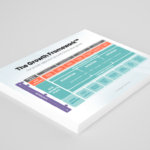 Do you ever find yourself listening to news about the most recent political embarrassment du jour and think to yourself: “that system is fundamentally broken. How did we get here?”
Do you ever find yourself listening to news about the most recent political embarrassment du jour and think to yourself: “that system is fundamentally broken. How did we get here?”
Yeah, me neither. Everything is just peachy.
Except when it isn’t. And when I’m not literally screaming at the radio while I’m in traffic, I’m trying not to scream into the middle distance at meetings.
Should I be seeking professional help? Yes, but this post is about something else. It’s about B2B.
This system is fundamentally broken. How did we get here?
Here’s my take:
The best practices of content marketing according to “thought leaders”
Long ago (I don’t know, maybe ten years), B2B marketers were inundated with content talking about content (let’s call this stuff MetaMarketing). A handful of tech companies started creating a ton of guides, eBooks, whitepapers, etc. on the subject of modern content marketing and a series of related topics that hit marketing-operations folks. The purpose was to “teach” marketing leaders how to do modern digital marketing.
What this content was really seeking to achieve was convincing its audiences that modern marketing was better when it was automated, at-scale, and very complex. The crux was that any successful program was dependent on sometimes hundreds of pieces of collateral, multiple emails to different persona types, and some tool at the center to pull it all together simply.
The creators of the content sold the tools at the center. It was genius.
B2B research, analysts, and consulting firms hopped on the bandwagon as well. There was a wholesale embrace of complexity, and the platforms and training organizations saw the opportunities to not only capitalize off the new, unnecessarily complex B2B marketing world, but also further add to the complexity.
It was like chicken vs egg, if the chicken was the company trying to sell you things and the egg was about to hatch into something that was going to try and sell you things.
Most B2B marketers in action today grew up on this content, and for better or worse (but, seriously, way, way worse than better), the foundational elements of most modern-day programs still pull heavily from ideas and rules introduced within that wave of MetaMarketing content.
Some of the takeaways that still plague our programs today
There are many, but here are the big ones.
- Campaigns need to be made up of tons of content. That content should be in the format of guides, infographics, whitepapers, etc… (brought to you by content management platforms)
- Because email was/is the workhorse, and people tend to miss a lot of emails in their inbox, your campaign has to run forever and have tons of emails to capitalize off the brief moments of active demand or engagement. (brought to you by marketing automation platforms)
- Messaging starts off as status-quo-disrupting (but mostly how-to and thought leadership) content, then moves to topics that make subtle connections between what your audience needs and what you do, and then finally, for the denouement, your content shifts to sales-heavy language and focuses on case studies and testimonials. (brought to you by strategy organizations)
- There is a scientific way to approach messaging and campaign architecture. The right messaging/architecture follows a lengthy and specific process of research that is difficult to do in-house and needs to account for more and more complexity over time. (brought to you by research organizations)
You see what’s happening here?
Quick question. If the above messages didn’t come from companies that sold products and services that enable you to bring those best practices to your organization, do you think they would have emerged as best practices organically?
Marketing strategy becomes content becomes truth becomes gospel
As someone who has dedicated the bulk of his professional life to creating B2B marketing programs, I’ll tell you that nearly 100% of the time, the above best practices are just baked into everything. It’s not that a client comes with preconceived notions about them. It’s not that we cram them down client’s throats. They are such embedded truths that no one even bothers debating them.
When you walk into a conference room, do you immediately confirm that there will be enough oxygen for the duration of the meeting? Of course not. It doesn’t even occur to you. You just breathe. That’s kind of where we’re at with these supposed best practices.
And the painful truth: A lot of it is made up. And the result has been categorically poor performance across the vast majority of B2B campaigns. It’s just embarrassing how ineffective some of this stuff can be.
So, yeah, I think it’s time to blow it up
What am I proposing here instead of what we’ve been doing, you may ask? Fair enough. I mean, it’s not all that valuable to rail against a system unless you have good ideas for changing it (unless you’re in politics, and then it seems very valuable to approach in that way).
There are a few things we need to accept:
- Your audiences don’t engage with your strategy. They engage with your creative ideas. That’s why they are clicking on anything. Your ideas should drive your tactics, not the other way around. And, your ideas need to actually be creative. Hyper-rational and sober messaging is why click rates are so damn low. If you’re in denial about this, enjoy your poor performance.
- The idea that your audience doesn’t recognize that you’re giving them product sheets masquerading as infographics and whitepapers in incredibly naïve. They get it. Most people can immediately tell when a person is talking about himself, no matter how cleverly he tries to veil it under a seemingly unrelated topic. It’s sloppy. It’s embarrassing. Stop doing it.
- How long and complex should a campaign be? No idea. You don’t know. No one does. How about this: don’t feel like you need to decide in phase one. NASA didn’t shoot for the moon on day one. Scientists had to first be sure that someone could survive in space that long, then they had to ensure they could land, then they had to ensure someone could survive outside of the landing craft, then takeoff, then rendezvous with another orbiting craft, then get back into our orbit, and then survive reentry and a landing. Start small, define a hypothesis, and learn from each launch.
- Stop pretending you can know what your audience is going to do. There is no predictable process unless you’re driving them from milestone to milestone. And if that’s your approach, know that many will see the impending milestones, and go, “no thanks,” and leave. You need to build experiences that they can explore. Are you going to put them in a maze, see what they do, and then design the perfect maze? I don’t know. I think that’s doubtful. I think the best you can hope for is proving engagement on a small scale, and then ramping up what’s working. But this idea that contained within some PowerPoint is a magical journey that outlines the steps your audience takes to buy something is just a fantasy.
Reality check
This is normally where we place our summary and parting call-to-action. But here’s what I desperately want you, dear reader, to take away from this. Stop perpetuating those four best practices I identified in the beginning of this post. Stop the shitty marketing.
Here’s how:
#1
If you’re the one doing the shitty marketing, please pull the emergency brake and immediately take stock of what you can salvage and repurpose (there will be plenty, I’m sure). Then, do better. It’s not about ego. The world much prefers the captain that realizes the ship’s off course and corrects–not the captain who’s tight-lipped until the ship finally runs aground.
#2
If you’re the one thinking, “this marketing is shitty,” but not saying anything, it’s time to speak up. The shitty stuff isn’t just shitty, it’s ineffective. There is no defensible position left to protect that status quo. Start a revolution already. I know the average engagement rates. Trust me, you’re not sacrificing much by trying something new.
#3
And for the readers rolling their eyes, folks, you will eventually come around. I’m sure of it. This isn’t a case of someone looking into the future and trying to predict what’s to come based on today’s numbers and where they are trending. This is me looking at today’s numbers, and last year’s, and so on. It’s not that we’re worried things are about to get bad. They’ve been bad for so long, and everyone is either ignoring or rationalizing it.
It’s time to remake B2B. Who’s ready?
Read more from Intelligent Demand
- 6 Smart Strategies to Make Creative Work Harder for Lead Gen
- How to A/B Test Ads, Landing Pages, and Emails the Right Way
- Comparing Smart AI Application Across B2B Campaign Strategies
- Spot the Red Flags: When to Transform Your B2B Marketing Organization
- The Intersection of AI and RevOps: Data Infrastructure, Cross-Functional Alignment, & Tech




